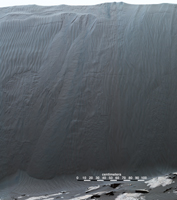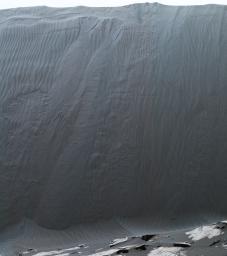
Figure 1
Click on the image for larger versionThis view combines multiple images from the telephoto-lens camera of the Mast Camera (Mastcam) on NASA's Curiosity Mars rover to reveal fine details of the downwind face of "Namib Dune." The site is part of the dark-sand "Bagnold Dunes" field along the northwestern flank of Mount Sharp. Images taken from orbit have shown that dunes in the Bagnold field move as much as about 3 feet (1 meter) per Earth year.
Sand on this face of Namib Dune has cascaded down a slope of about 26 to 28 degrees. The top of the face is about 13 to 17 feet (4 to 5 meters) above the rocky ground at its base.
The downwind side of a sand dune displays textures quite different from those seen on other surfaces of the dune. Compare this scene, for example, to a windward surface of nearby "High Dune" (see PIA20168). As on Earth, the downwind side of these Martian dunes has a steep slope called a slip face, where accumulating sand flows in mini-avalanches down the face.
The component images of this mosaic view were taken on Dec. 21, 2015, during the 1,200th Martian day, or sol, of Curiosity's work on Mars. The mission's examination of dunes in the Bagnold field, along the rover's route up the lower slope of Mount Sharp, is the first close look at active sand dunes anywhere other than Earth.
The scene is presented with a color adjustment that approximates white balancing, to resemble how the sand would appear under daytime lighting conditions on Earth. Figure 1 includes a superimposed scale bar of 100 centimeters (39.4 inches).
Malin Space Science Systems, San Diego, built and operates the rover's Mastcam. NASA's Jet Propulsion Laboratory, a division of the California Institute of Technology, Pasadena, manages the Mars Science Laboratory Project for NASA's Science Mission Directorate, Washington. JPL designed and built the project's Curiosity rover.
For more information about Curiosity, visit http://www.nasa.gov/msl and http://mars.jpl.nasa.gov/msl/.

 Planetary Data System
Planetary Data System













